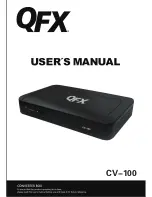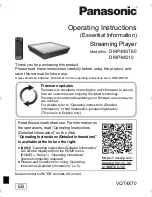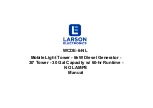
Xtium-CL PX4 User's Manual
Troubleshooting Problems
•
27
•
Select Information to display identification and information stored in the Xtium-CL PX4
firmware.
•
Select Firmware to display version information for the firmware components.
•
Select one of the firmware components to load custom firmware when supplied by Teledyne
DALSA engineering for a future feature.
•
Click on File • Save Device Info to save all information to a text file. Email this file when
requested by Technical Support.
Teledyne DALSA Log Viewer
The third step in the verification process is to save in a text file the information collected by the
Log Viewer program. Run the program via the Windows Start Menu shortcut Start • Programs •
Teledyne DALSA • Sapera LT • Tools • Log Viewer.
The Log Viewer lists information about the installed Teledyne DALSA drivers. Click on File • Save
and you will be prompted for a text file name to save the Log Viewer contents. Email this text file
to Teledyne DALSA Technical Support when requested or as part of your initial contact email.
On-board Image Memory Requirements for Acquisitions
The Xtium-CL PX4 by default will allocate the maximum number of buffers that can fit in on-board
memory based on the size of the acquired image before cropping, to a maximum of 65535 buffers.
Note that an application can change the default number of on-board frame buffers using the
Sapera LT API. Usually two buffers will ensure that the acquired video frame is complete and not
corrupted in cases where the image transfer to host system memory may be interrupted and
delayed by other host system processes. That is, there is no interruption to the image acquisition
of one buffer by any delays in transfer of the other buffer (which contains the previously acquired
video frame) to system memory.
If allocation for the requested number of buffers fails, the driver will reduce the number of on-
board frame buffers requested until they can all fit.
For area scan cameras, a minimum of 2 on-board frame buffers is needed for proper operation.
For line scan cameras, if there is not enough memory for 2 on-board buffers, the driver will
reduce the size such that it allocates two partial buffers. This mode is dependent on reading out
the image data to the host computer faster than the incoming acquisition.
The maximum number of buffers that can fit in on-board memory can be calculated as follows:
(Total On-Board memory / (Buffer Size in Bytes + 256 Bytes used to store the DMA)).
For example, assuming 512MB of on-board memory and acquiring 1024 x 1024 x 8 bit images, the
number of on-board buffers would be: 512 MB / [(1024 x 1024) + 256] = 511.875 => 511 on-
board buffers.
Symptoms: CamExpert Detects no Boards
•
When starting CamExpert, with no Teledyne DALSA board detected, CamExpert will start in
offline mode. There is no error message and CamExpert is functional for creating or
modifying a camera configuration file. If CamExpert should have detected an installed board
frame grabber, troubleshoot the installation problem as described below.
Troubleshooting Procedure
When CamExpert detects no installed Teledyne DALSA board, there could be a hardware problem,
a system bus problem, a kernel driver problem, or a software installation problem.
•
Make certain that the card is properly seated in PCIe slot.
•
Perform all installation checks described in this section before contacting Technical Support.
•
Try the board in a different PCIe slot if available.
















































